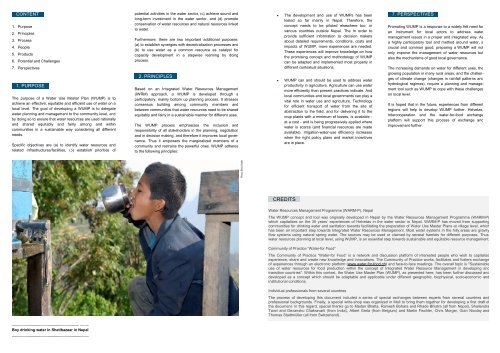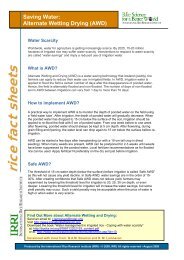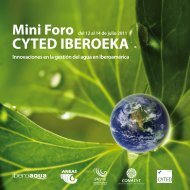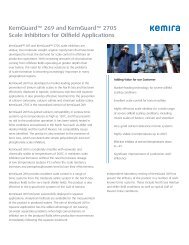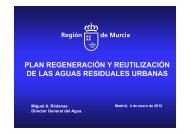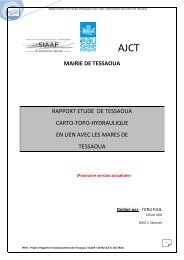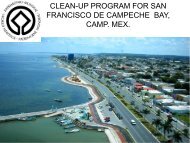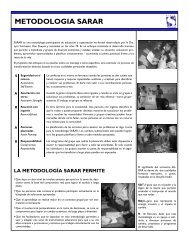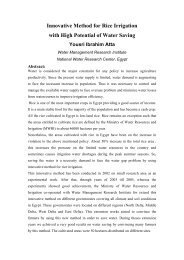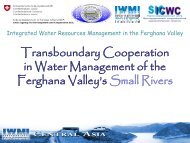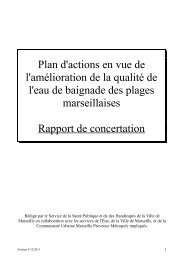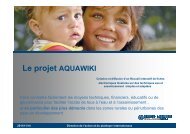water use master plan (wump) - Solutions for Water platform - World ...
water use master plan (wump) - Solutions for Water platform - World ...
water use master plan (wump) - Solutions for Water platform - World ...
You also want an ePaper? Increase the reach of your titles
YUMPU automatically turns print PDFs into web optimized ePapers that Google loves.
CONTENT!!!<br />
1. Purpose<br />
2. Principles<br />
3. Process<br />
4. People<br />
5. Products<br />
6. Potential and Challenges<br />
7. Perspectives<br />
!!!1. PURPOSE!!!<br />
The purpose of a <strong>Water</strong> Use Master Plan (WUMP) is to<br />
achieve an effective, equitable and efficient <strong>use</strong> of <strong>water</strong> on a<br />
local level. The goal of developing a WUMP is to delegate<br />
<strong>water</strong> <strong>plan</strong>ning and management to the community level, and<br />
by doing so to ensure that <strong>water</strong> resources are <strong>use</strong>d rationally<br />
and shared equitably and fairly among and within<br />
communities in a sustainable way considering all different<br />
needs.<br />
Specific objectives are (a) to identify <strong>water</strong> resources and<br />
related infrastructures/facilities, (b) establish priorities of<br />
potential activities in the <strong>water</strong> sector, (c) achieve sound and<br />
long-term investment in the <strong>water</strong> sector, and (d) promote<br />
conservation of <strong>water</strong> resources and natural resources linked<br />
to <strong>water</strong>.<br />
Furthermore, there are two important additional purposes:<br />
(a) to establish synergies with decentralization processes and<br />
(b) to <strong>use</strong> <strong>water</strong> as a common resource as catalyst <strong>for</strong><br />
capacity development in a stepwise learning by doing<br />
process.<br />
2. PRINCIPLES!!!<br />
Based on an Integrated <strong>Water</strong> Resources Management<br />
(IWRM) approach, a WUMP is developed through a<br />
participatory, mainly bottom up <strong>plan</strong>ning process. It stresses<br />
consensus building among community members and<br />
between communities that <strong>water</strong> resources need to be shared<br />
equitably and fairly in a sustainable manner <strong>for</strong> different <strong>use</strong>s.<br />
The WUMP process emphasizes the inclusion and<br />
responsibility of all stakeholders in the <strong>plan</strong>ning, negotiation<br />
and in decision making, and there<strong>for</strong>e it improves local governance.<br />
Thus it empowers the marginalized members of a<br />
community and restrains the powerful ones. WUMP adheres<br />
to the following principles:<br />
• The development and <strong>use</strong> of WUMPs has been<br />
tested so far mainly in Nepal. There<strong>for</strong>e, the<br />
concept needs to be piloted elsewhere too. in<br />
various countries outside Nepal. The In order to<br />
provide sufficient in<strong>for</strong>mation to decision makers<br />
about detailed requirements, conditions, costs and<br />
impacts of WUMP, more experiences are needed.<br />
These experiences will improve knowledge on how<br />
the promising concept and methodology of WUMP<br />
can be adapted and implemented most properly in<br />
different contextual situations.<br />
• WUMP can and should be <strong>use</strong>d to address <strong>water</strong><br />
productivity in agriculture. Agriculture can <strong>use</strong> <strong>water</strong><br />
more efficiently than present practices indicate. And<br />
local communities and local governments can play a<br />
vital role in <strong>water</strong> <strong>use</strong> and agriculture. Technology<br />
<strong>for</strong> efficient transport of <strong>water</strong> from the site of<br />
abstraction to the field, and <strong>for</strong> delivering it to the<br />
crop <strong>plan</strong>ts with a minimum of losses, is available -<br />
at a cost - and is being progressively applied where<br />
<strong>water</strong> is scarce (and financial resources are made<br />
available). Irrigation-<strong>water</strong>-<strong>use</strong> efficiency increases<br />
when the right policy <strong>plan</strong>s and market incentives<br />
are in place.<br />
!!!7. PERSPECTIVES!!!<br />
Promoting WUMP is a response to a widely felt need <strong>for</strong><br />
an instrument <strong>for</strong> local actors to address <strong>water</strong><br />
management issues in a proper and integrated way. As<br />
a highly participatory tool and method around <strong>water</strong>, a<br />
crucial and common good, preparing a WUMP will not<br />
only improve the management of <strong>water</strong> resources but<br />
also the mechanisms of good local governance.<br />
The increasing demands on <strong>water</strong> <strong>for</strong> different <strong>use</strong>s, the<br />
growing population in many rural areas, and the challenges<br />
of climate change (changes in rainfall patterns and<br />
hydrological regimes), require a <strong>plan</strong>ning and management<br />
tool such as WUMP to cope with these challenges<br />
on local level.<br />
It is hoped that in the future, experiences from different<br />
regions will help to develop WUMP further. Helvetas,<br />
Intercooperation and the <strong>water</strong>-<strong>for</strong>-food exchange<br />
plat<strong>for</strong>m will support this process of exchange and<br />
improvement further.<br />
Photo: Silvia Voser<br />
!!!CREDITS!!!<br />
<strong>Water</strong> Resources Management Programme (WARM-P), Nepal<br />
The WUMP concept and tool was originally developed in Nepal by the <strong>Water</strong> Resources Management Programme (WARM-P)<br />
which capitalizes on the 30 years’ experiences of Helvetas in the <strong>water</strong> sector in Nepal. WARM-P has moved from supporting<br />
communities <strong>for</strong> drinking <strong>water</strong> and sanitation towards facilitating the preparation of <strong>Water</strong> Use Master Plans at village level, which<br />
has been an important step towards Integrated <strong>Water</strong> Resources Management. Most <strong>water</strong> systems in the hilly areas are gravity<br />
flow systems using natural spring <strong>water</strong>. The sources may be <strong>use</strong>d or claimed by several hamlets <strong>for</strong> different purposes. Thus,<br />
<strong>water</strong> resources <strong>plan</strong>ning at local level, using WUMP, is an essential step towards sustainable and equitable resource management.<br />
Community of Practice “<strong>Water</strong>-<strong>for</strong> Food”<br />
The Community of Practice “<strong>Water</strong>-<strong>for</strong> Food” is a network and discussion plat<strong>for</strong>m of interested people who wish to capitalize<br />
experience, share and create new knowledge and innovations. The Community of Practice works, facilitates and fosters exchange<br />
of experiences through an electronic plat<strong>for</strong>m (www.<strong>water</strong>-<strong>for</strong>-food.ch) and face-to-face meetings. The overall topic is "Sustainable<br />
<strong>use</strong> of <strong>water</strong> resources <strong>for</strong> food production within the concept of Integrated <strong>Water</strong> Resource Management in developing and<br />
transition countries". Within this context, the <strong>Water</strong> Use Master Plan (WUMP), as presented here, has been further discussed and<br />
developed as a concept which should be adaptable and applicable under different geographic, biophysical, socio-economic and<br />
institutional conditions.<br />
Individual professionals from several countries<br />
The process of developing this document included a series of special exchanges between experts from several countries and<br />
professional backgrounds. Finally, a special write-shop was organized in Mali to bring them together <strong>for</strong> developing a first draft of<br />
the document. In this regard, special thanks go to Madan Bhatta, Ramesh Bohara and Rhade Bhistra (all from Nepal), Shailendra<br />
Twari and Devanshu Chakravarti (from India), Albert Grela (from Belgium) and Martin Fischler, Chris Morger, Gian Nicolay and<br />
Thomas Stadtmüller (all from Switzerland).<br />
.........................................................................<br />
Boy drinking <strong>water</strong> in Shatibazaar in Nepal<br />
.........................................................................


